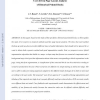Free Online Productivity Tools
i2Speak
i2Symbol
i2OCR
iTex2Img
iWeb2Print
iWeb2Shot
i2Type
iPdf2Split
iPdf2Merge
i2Bopomofo
i2Arabic
i2Style
i2Image
i2PDF
iLatex2Rtf
Sci2ools
IJDAR
2007
2007
User-driven page layout analysis of historical printed books
In this paper, based on the study of the specificity of historical printed books, we first explain the main error sources in classical methods used for page layout analysis. We show that each method (bottom-up and top-down) provides different types of useful information that should not be ignored if we want to obtain both a generic method and good segmentation results. Next, we propose to use a hybrid segmentation algorithm that builds two maps: a shape map that focuses on connected components and a background map which provides information about white areas corresponding to block separations in the page. Using this first segmentation, a classification of the extracted blocks can be achieved according to scenarios produced by the user. These scenarios are defined very simply during an interactive stage. The user is able to make processing sequences adapted to the different kinds of images he is likely to meet and according to the user needs. The proposed “user driven approach” is c...
Related Content
| Added | 15 Dec 2010 |
| Updated | 15 Dec 2010 |
| Type | Journal |
| Year | 2007 |
| Where | IJDAR |
| Authors | Jean-Yves Ramel, S. Leriche, M. L. Demonet, S. Busson |
Comments (0)

